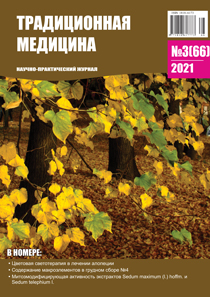Study of peculiarities of flavonoids accumulation in common tansy flowers harvested in various urban and agrobiocenoses of Voronezh region
DOI:
https://doi.org/10.54296/18186173_2021_3_33Keywords:
Voronezh region, common tansy, FlavonoidsAbstract
An important and little-researched aspect of the effect of human economic activity on medicinal plants is that in response to an increase in anthropogenic load, additional synthesis of secondary metabolites, especially flavonoids, is induced, which play an important role in adapting plants to changing conditions. The purpose of the study was to study the accumulation of flavonoids and phenol carboxylic acids in the flowers of common tansy, collected in various agricultural and urbobiogeocenoses of the Voronezh region from the point of view of anthropogenic impact. As part of the study, the content of the sum of flavonoids and phenol carboxylic acids in terms of luteolin was determined in 51 samples of common tansy flowers. It was revealed that in the flowers of common pajma harvested in agrobiogeocenoses and in a number of urbobiocenoses, the content of flavonoids is generally higher than in samples collected in natural biocenoses of protected areas. This fact can be explained by the biochemical adaptation of the plant to significant oxidative stresses, in response to which the synthesis of polyphenol substances, the main representatives of which are flavonoids, is induced. At the same time, near some production plants and along highways with high traffic intensity, we selected samples with a content of flavonoids and phenol carboxylic acids in terms of luteolin reduced relative to other samples of raw materials. This suggests that with the excessive toxic influence of pollutants, it is also possible to suppress the antioxidant system of plants.
References
Дьякова, Н.А. Оценка эффективности и безопасности лекарственного растительного сырья подорожника большого, собранного в Центральном Черноземье / Н.А. Дьякова, А.И. Сливкин, С.П. Гапонов // Вестник ВГУ. Серия: Химия, Биология, Фармация. – 2018; 1: 124–131.
Analysis of the relationship between the accumulation of pollutants and principal groups of biologically active substances in medicinal plant raw materials using knotweed (Polygonum aviculare L.) and broadleaf plantain (Plantago major L.) leaves as examples / N.A. Dyakova, A.I. Slivkin, S.P. Gaponov [et al.] // Pharmaceutical Chemistry Journal. – 2015; 49(6): 384–387.
Великанова, Н.А. Экологическая оценка состояния лекарственного растительного сырья (на примере Polygonum aviculare L. и Plantago major L.) в урбоусловиях города Воронежа и его окрестностей: автореф. дис. ... канд. биол. наук / Н.А. Великанова. – Воронеж: Изд-во ВГУ, 2013: 21.
Куркин, В.А. Фармакогнозия / А.В. Куркин. — Самара: Офорт, 2004: 406–410.
Баяндина, И.И. Взаимосвязь вторичного метаболизма и химических элементов в лекарственных растениях / И.И. Баяндина, Ю.В. Загурская // Сибирский медицинский журнал. – 2014; 8: 107–111.
Loreto, F. Abiotic stresses and induced biogenic volatile organic compounds / F. Loreto, J.-P. Schnitzler // Trends in Plant Science. – 2010; 15: 154–166.
Flavonoids as Antioxidants in Plants Under Abiotic Stresses / M.D. Ferdinando, C. Brunetti, A. Fini, M. Tattini // Abiotic stress responses in plants: metabolism, productivity and sustainability / Ed. P. Ahmad, M.N.V. Prasad. – NY: Springer New York, 2012: 159–179.
Государственная фармакопея Российской Федерации. Издание XIV. Том 4. — М.: ФЭМБ, 2018: 6328–6335.
Rice-Evans, C.A. Structure – antioxidant activity relationships of flavonoids and phenolic acids / C.A. Rice-Evans, N.J. Miller, G. Papanga // Free Radical Biology and Medicine. – 1996; 20: 933–956.
Winkel-Shirley, B. Biosynthesis of flavonoids and effect of stress / B. Winkel-Shirley // Current Opinion in Plant Biology. – 2002; 5: 218–223.
Downloads
Published
How to Cite
Issue
Section
License
Reproduction of any materials without the written permission of the publisher is prohibited.
The responsibility for the accuracy of the information contained in articles and advertisements are the authors and advertisers.






